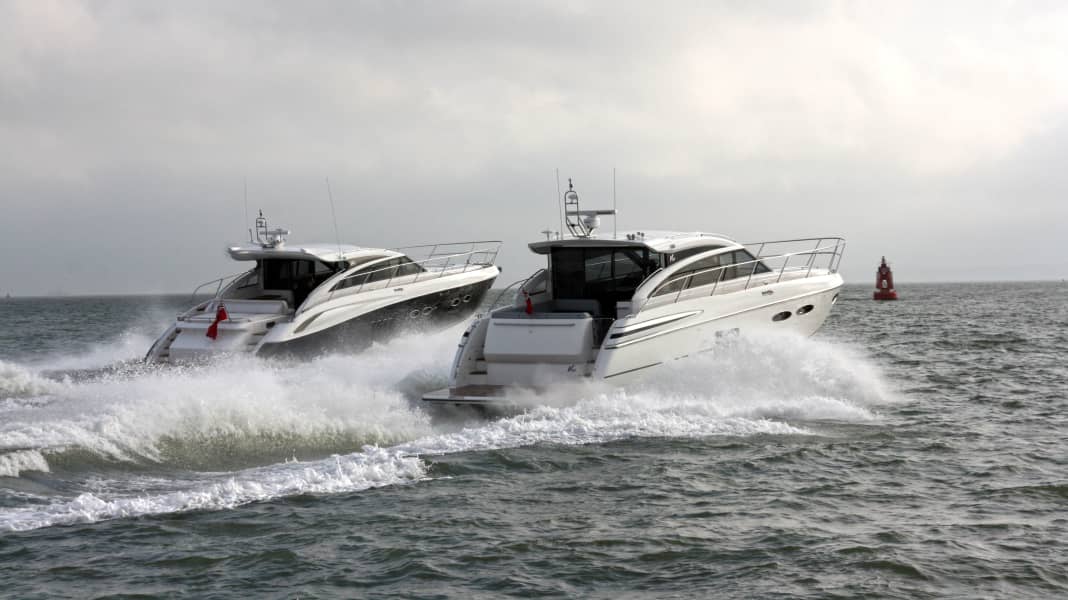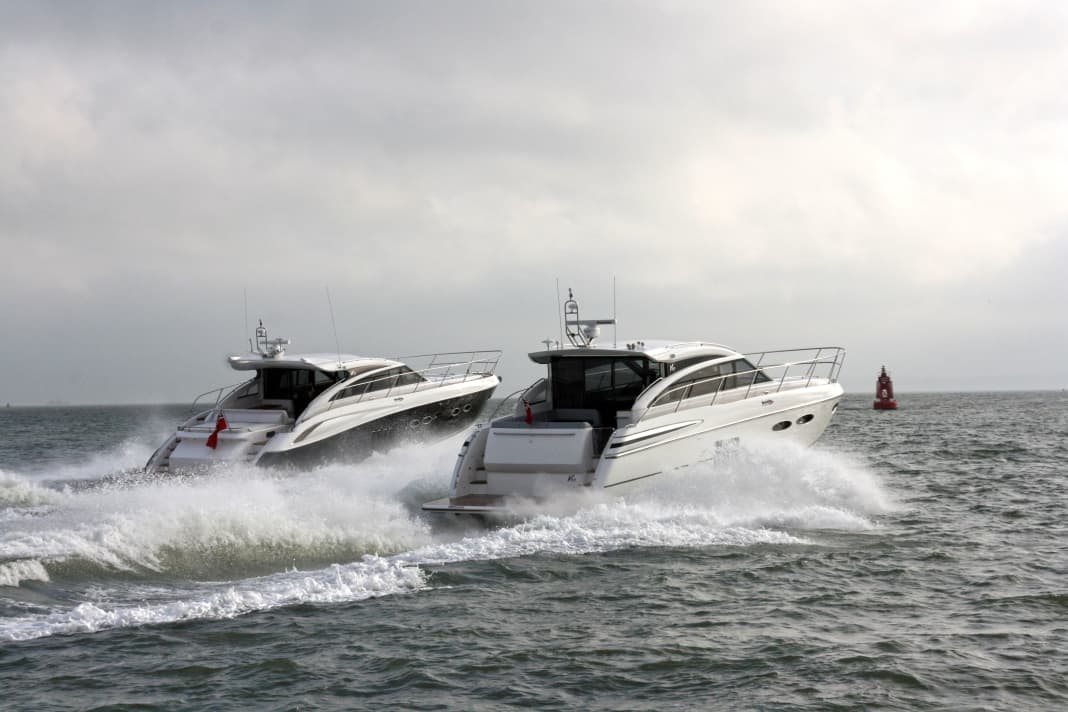

Princess is undoubtedly one of the finest shipyards in the UK. Since 1964, floating dreams have been built there, which today are categorised into M, Flybridge and V-Class. We drive two V-Class boats, as the shipyard calls its yachts from 13.50 metres to almost 26 metres in length, which look like large day cruisers.






The distinctive features of these models are the hardtops equipped with sliding roofs and, on the larger boats, the glass partition wall to the cockpit. We drive a Princess V52 and the ten-foot longer V62.
While in the V52 two in-line six-cylinder engines from Caterpillar each deliver 715 hp to the propeller shafts, in the V62 two MTU V8s combine to produce 2536 hp on the shaft systems. To avoid going too fast in the harbour, you can use the trolling device - if available - or alternately shift one gear train each to "forward" and neutral. With the latter, both test boats are still travelling at 6 knots.
To avoid creating unnecessary waves at slow speeds, it is recommended that the engines in both boats do not exceed 800 rpm, which is good for 8 knots in the V52 and 9 knots in the V62. At almost the same speed (1200 rpm), a smooth water break at the stern signals the transition from displacement to planing speed. A barely noticeable sinking bow on the V52 around 1500 rpm or at 18 knots indicates that she has switched to planing.
The same happens on the V62 when the engines are turning 1800 rpm at a speed of 24 knots. The V52 is travelling at a maximum speed of 34 knots, the V62 at 37 knots. After analysing our measurement data for the V52, we calculated that the cats need to turn at 1700 rpm and the MTUs at 2100 rpm in order to achieve the greatest range at fast planing speeds of 23 kn (V52) and 29 kn (V62).
With the 2000 litres of diesel in the former, you can theoretically get just as far as with the 3409 litres in the V62, which in figures means around 285 nm until you reach the reserve. At full throttle, the tank fillings are sufficient for a non-stop journey of around 230 nm plus reserves. This means that both test candidates fulfil our minimum requirement of 270 nm plus reserve in economical cruising.
Counter-rotating propellers plus bow thruster allow both boats to turn almost on the spot. If both control levers are set to "ahead" at slow speed, a full circle measures around 90 metres for the V52 and 120 metres for its sister boat, and you have to calculate around 200 metres for both at planing speed. If one drive train fails, the V52 can still be pushed through the water at a maximum speed of 13.6 knots in an emergency, the V62 at 11 knots.
The sound pressure in the cockpit of the V52 rises above 85 dB/A from 1700 rpm and remains only 3 dB/A below this in the saloon, for which the rear air conditioning outlet grilles are partly responsible. The situation is better with the V62, where we measured a maximum of 78 dB/A in the saloon and no more than 85 dB/A in the cockpit.
The driving positions on the boats give little cause for criticism. The drivers sit in front of clearly laid out dashboards and have everything under control and in view. The bucket seat in the V62 is criticised for its steel frame, which is not completely covered in leather. There is a risk of injury from the sharp-edged corners. On the other hand, the driver and co-driver feel comfortable, which is not the case for the passenger on the V52, as there is no lateral support to port. Rough water was also missing - the waves of commercial shipping posed no challenge for the test boats.
As far as the driving experience is concerned, the V62 feels more lively and agile than the V52, as the centrifugal forces also show. While we measured no more than 0.3 g at the steering position when cornering in the V52, the V62 measured 0.5 g under the same conditions. This means that everything is perfectly stable and passengers are not unpleasantly surprised.
The V52 is available with two or three cabins including one for the crew, a WC/shower room, the day bathroom for guests and a separate WC/shower room for the owner. The galley is also located on the living level, with another available in the cockpit.
We sail the V52 with two cabins, where there is a dinette instead of a third cabin. And the guest cabin in the foredeck has two single berths. The V62 has three cabins plus one for the crew. While the guests share a day bathroom with WC and shower, the owner also has his own elegant retreat here.
The mechanic is delighted with the engine compartment in the V52, which can be easily accessed through a cockpit floor hatch. The only worrying thing is that the diesel lines of the starboard engine are stepped on when climbing up and down and, as found, have already been bent in the process. There are two Caterpillar diesels in the engine compartment, which deliver their power via V-gearboxes. This has the advantage that the engine compartment does not have to be so large.
It's a tight squeeze for service personnel, but nothing stands in the way of daily checks. Although the two fuel pre-filters deserve praise, they are of no value without water alarm sensors. And the "ventilation of the engine compartment" does not prevent the intake air of the engines from rising to over 32 °C at 9 °C outside temperature.
The engine compartment in the V62 is also accessible through a cockpit floor hatch, but is much less convenient than in the V52. In addition, it is really cramped here, as space is needed for a tender garage above, which is accessible from the outside under the folding rear couch. At least the fuel pre-filters in the V62 have been fitted with alarm sensors. Despite the cramped conditions, the "ventilation of the engine compartment" is also good: with an outside temperature of 9 °C, it did not get warmer than 20 °C at the air filters.
It is commendable that the fuel taps on both boats can be operated remotely, and switchable manual bilge pumps can control individual sections in an emergency. The automatic fuses on the helm stations and the relay-controlled main switches in the switch panels in the boat are also perfectly located.
As far as the extra 10 feet in length in the V62 is concerned, this does not benefit the forward cabin; on the contrary, it is almost 20 cm shorter than that of the V52. On the other hand, both owner's cabins are the same length under the saloon floors. The dimensions in the deck saloons with driving positions are also unequal. The V62 is around 13 cm shorter than the V52.
The V62 is only ahead of the V52 in terms of saloon length below deck. However, the galley with fridge and freezer is longer in the V52. The space to starboard is also longer in the V52, where the dinette is located, because in the V62 the double cabin is immediately adjacent to the bench seat with table and therefore the owner's cabin is also installed further aft than in the V52.
The cockpit of the V62 is only slightly longer if you take the measurement from the saloon door to the back cushions of the rear bench seat. But then comes the stern, including the sunbed and bathing platform, which is visibly longer than on the V52. The foredeck and day bath on the V62 are unbeatably longer. And the owner's bathroom with shower and toilet is larger overall than that on the V52.
But if you think that the V62 is the same length as the V52 or shorter, it also offers less space, you're wrong. The V62 gets this from its greater width, which is 0.54 metres wider. Nominally not much, but in terms of length it makes the decisive difference and offers more comfort. According to the shipyard, the V52 does not require its own patent on the Rhine because the boat is just under the 15-metre patent requirement mark at 14.98 metres, excluding appendages and overhangs.
Conclusion: As far as most of the workmanship on both boats is concerned, as well as the technical and electrical installations, there is nothing significant to criticise, except for the fine tuning in the deck saloon of the V62, where we saw a few places that are not worthy of a princess, the V52 is better there.

